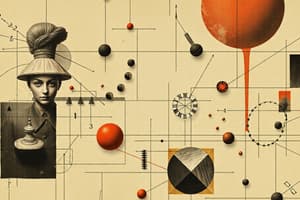Podcast
Questions and Answers
Which of the following best describes pure mathematics?
Which of the following best describes pure mathematics?
- Mathematics focused solely on practical applications in fields like engineering and finance.
- The application of existing mathematical knowledge to other disciplines.
- Mathematics conducted without consideration of practical applications. (correct)
- The use of mathematical principles to develop new technologies.
The development of mathematics has been independent of the progress of civilization.
The development of mathematics has been independent of the progress of civilization.
False (B)
What is the etymological origin of the word 'mathematics', and what does it mean?
What is the etymological origin of the word 'mathematics', and what does it mean?
The word 'mathematics' comes from the Greek word máthēma, meaning 'knowledge, study, learning'.
The fields of mathematical logic and ______ were developed to clarify the foundations of mathematics.
The fields of mathematical logic and ______ were developed to clarify the foundations of mathematics.
Match the following historical periods/regions with their contributions to mathematics:
Match the following historical periods/regions with their contributions to mathematics:
Which area of mathematics involves the rigorous axiomatic framework?
Which area of mathematics involves the rigorous axiomatic framework?
Applied mathematics has no influence on the development of new mathematical disciplines.
Applied mathematics has no influence on the development of new mathematical disciplines.
Name three broad areas into which modern mathematics can be grouped.
Name three broad areas into which modern mathematics can be grouped.
Which branch of mathematics uses algebraic techniques to solve geometric problems?
Which branch of mathematics uses algebraic techniques to solve geometric problems?
Functional analysis primarily focuses on the study of discrete mathematical structures.
Functional analysis primarily focuses on the study of discrete mathematical structures.
What is the branch of mathematics that deals with shapes, sizes, relative positions of figures, and the properties of space?
What is the branch of mathematics that deals with shapes, sizes, relative positions of figures, and the properties of space?
The field of mathematics that studies ways of arranging things, including permutations and combinations, is known as ______.
The field of mathematics that studies ways of arranging things, including permutations and combinations, is known as ______.
Match the following mathematical areas with their primary focus:
Match the following mathematical areas with their primary focus:
Which of the following is NOT a typical application of mathematics?
Which of the following is NOT a typical application of mathematics?
Mathematical notation is intentionally ambiguous to allow for multiple interpretations.
Mathematical notation is intentionally ambiguous to allow for multiple interpretations.
What type of argument is used in mathematics to demonstrate the truth of a mathematical statement?
What type of argument is used in mathematics to demonstrate the truth of a mathematical statement?
Unlike science, which relies on observation and experiment, mathematics relies on ______ and deduction.
Unlike science, which relies on observation and experiment, mathematics relies on ______ and deduction.
Which of the following is an example of an open problem in mathematics?
Which of the following is an example of an open problem in mathematics?
Flashcards
Mathematics
Mathematics
Abstract study of quantity, structure, space, and change.
Applied Mathematics
Applied Mathematics
Applying math to real-world problems, inspiring new math.
Pure Mathematics
Pure Mathematics
Mathematics studied for its own sake, without needing application.
Early Mathematics
Early Mathematics
Signup and view all the flashcards
Ancient Greek Math
Ancient Greek Math
Signup and view all the flashcards
Hindu-Arabic Numerals
Hindu-Arabic Numerals
Signup and view all the flashcards
Mathematical Logic
Mathematical Logic
Signup and view all the flashcards
Set Theory
Set Theory
Signup and view all the flashcards
What is Algebra?
What is Algebra?
Signup and view all the flashcards
What is Analysis?
What is Analysis?
Signup and view all the flashcards
What is Geometry?
What is Geometry?
Signup and view all the flashcards
What is Combinatorics?
What is Combinatorics?
Signup and view all the flashcards
What is Statistics?
What is Statistics?
Signup and view all the flashcards
What is Numerical Analysis?
What is Numerical Analysis?
Signup and view all the flashcards
What is Operations Research?
What is Operations Research?
Signup and view all the flashcards
What is Math Notation?
What is Math Notation?
Signup and view all the flashcards
What are Proofs?
What are Proofs?
Signup and view all the flashcards
What is Category Theory?
What is Category Theory?
Signup and view all the flashcards
Study Notes
- Mathematics is the abstract study of quantity, structure, space, and change.
- Views on the exact scope and definition of mathematics vary among mathematicians and philosophers.
- Mathematics is an essential tool used globally in fields like natural science, engineering, medicine, finance, and social sciences.
- Applied mathematics inspires and utilizes new mathematical discoveries, leading to the development of new mathematical disciplines.
- Mathematicians engage in pure mathematics for its own sake, without immediate applications in mind.
- The line between pure and applied mathematics is often blurred, as practical applications for pure mathematics are often discovered later.
History
- The history of mathematics stretches back thousands of years and is intertwined with the progress of civilization.
- Mathematics began with counting.
- Ancient Egypt and Babylonia made major advances, using mathematics for surveying, trade, and astronomy.
- The Ancient Greeks introduced mathematical rigor and proof, with significant advancements in geometry.
- The Hindu–Arabic numeral system, now used worldwide, evolved in India during the first millennium AD and was transmitted to the Western world via Islamic mathematics.
- Mathematics has greatly expanded, with a fruitful interaction between mathematics and science.
- Mathematical discoveries continue to be made today.
Etymology
- The word "mathematics" originates from the Greek word "máthēma," meaning "knowledge, study, learning."
- The term was first used around 300 BC.
- The adjective "mathematical" means "relating to mathematics."
Areas of Mathematics
- Modern mathematics comprises numerous subfields.
- These subfields can be broadly grouped into foundations, algebra, analysis, geometry, combinatorics, and applications.
Foundations and Philosophy
- Fields like mathematical logic and set theory were developed to clarify the foundations of mathematics.
- Mathematical logic focuses on establishing mathematics on a rigorous axiomatic framework and studies the results of such a framework.
- Set theory studies sets, which are collections of objects, and serves as a foundation for most of mathematics.
- Category theory is another foundational area that approaches mathematical structures and their relationships abstractly.
Algebra
- Algebra is the general study of mathematical symbols and the rules for manipulating them.
- Elementary algebra focuses on solving equations using variables that represent numbers.
- Abstract algebra studies algebraic structures such as groups, rings, and fields, generalizing ideas originating in elementary algebra.
- Algebra is essential in all areas of mathematics.
- Algebraic geometry uses algebraic techniques to solve geometric problems.
Analysis
- Analysis studies real numbers, complex numbers, and functions.
- Key concepts include limits, continuity, differentiation, integration, and infinite series.
- Calculus, including differential and integral calculus, is a major part of analysis.
- Functional analysis studies vector spaces of functions and is a major part of analysis.
- Analysis has many applications in physics, engineering, and economics.
Geometry
- Geometry is one of the oldest branches of mathematics.
- It deals with shapes, sizes, relative positions of figures, and the properties of space.
- Plane geometry deals with shapes that can be drawn on a plane.
- Solid geometry studies three-dimensional objects.
- Geometry features in art, architecture, and other fields.
- Topology describes properties that only change qualitatively if a shape is stretched or bent.
- Differential geometry uses calculus to study the properties of curves and surfaces.
Combinatorics
- Combinatorics studies ways of arranging things, including permutations and combinations.
- Graph theory, which studies graphs, is also considered part of combinatorics.
- Combinatorics is used in computer science.
Applications
- Mathematics is widely used in science, engineering, and other fields.
- Statistics is used to analyze data and make predictions.
- Numerical analysis develops algorithms for solving mathematical problems with computers.
- Operations research optimizes processes such as scheduling and logistics.
- Mathematics is also used in finance and economics.
- Game theory was invented by mathematicians to deal with topics in economics and strategy.
Mathematical Notation
- Mathematical notation has evolved over the centuries and is now standardized.
- It uses symbols to represent numbers, operations, functions, and other mathematical objects.
- Mathematical notation makes it easier to express mathematical ideas clearly and concisely.
Rigor and Proof
- An important aspect of mathematics is its commitment to rigor and proof.
- Mathematical proofs are arguments that demonstrate the truth of a mathematical statement.
- Proofs are used to establish new results.
- Proofs ensure that mathematics is consistent and reliable.
Mathematics as a Science
- Whether mathematics is a science is debated.
- Science involves observation and experiment, while mathematics relies on logic and deduction.
- Mathematics is used extensively in science, and scientific problems often inspire new mathematical theories.
- Mathematics possesses some attributes of a science, though it doesn't perfectly fit the definition.
- Mathematics shares characteristics with non-science fields like art.
Open Problems
- Mathematics is still an active area of research.
- Many unsolved problems exist, such as the Riemann hypothesis and the Goldbach conjecture.
- New mathematical theories are constantly being developed, and new connections between different areas of mathematics are being discovered.
Studying That Suits You
Use AI to generate personalized quizzes and flashcards to suit your learning preferences.




